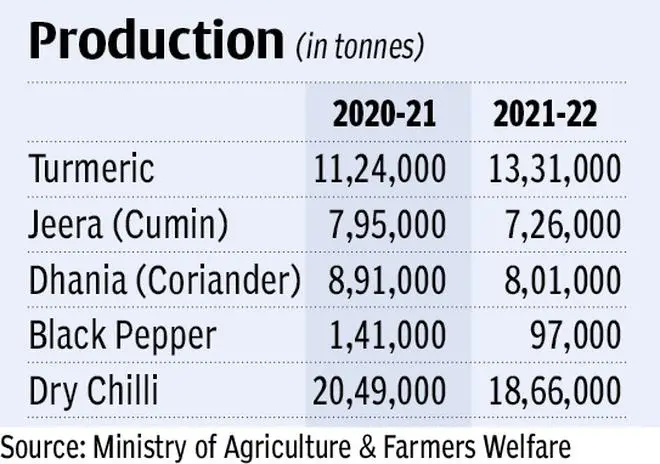Vegetables retail inflation is high, but spices is higher, retail inflation data showed. Experts say key reasons for higher inflation among spices are pest attack and lower production. They hope delayed monsoon may help better sowing of spices seed.
According to data from Statistics Ministry, vegetables retail inflation touched 13.23 per cent, while for spices, it recorded 14.90 per cent in August. All the five key spices included in the basket of CPI rose in August with dried chilli (Red Chilli) topping the list, while turmeric’s retail inflation rise was moderate. Data from Agriculture Ministry showed barring turmeric, production of jeera, dhania, black pepper and dry chilli dropped.
Spices and vegetables among others pushed the food inflation based on Consumer Food Price Index (CFPI). Rajani Sinha, Chief Economist with CareEdge, says: “Cereals, milk, vegetables, pulses, spices and packaged food witnessing a higher inflation during the month. These items have a combined weightage of nearly 32 per cent in the overall CPI basket.”
Food CPI soars
In a note SBI’s Economic Research Department said that food CPI soared to 7.57 per cent in August as compared to 6.71 per cent in July due to huge increase in prices of cereals, vegetables, pulses and spices (by more than 200 bps m-o-m).
Talking about spices, Bhagirath Choudhary, Head of Jodhpur-based South Asia Biotechnology Centre, said that majority of spices are under considerable supply constraint due to reduced area, biotic stresses and lower than expected production in Rabi 2021-22. In particular, chilli production was significantly down due to severe infestation of black thrips - an invasive pest of chilli. Farmers had limited option to manage devastation black thrips and lost majority of crop. On contrary, cumin was lost to fusarium wilt and Alternaria blight and mounting losses at grain development stages due to early arrival of hot western winds in Western Rajasthan.

“Providing timely and adequate support to tackle emerging pests and pathogen to smallholder spices farmers are critical to maintain India’s supremacy in spices production and export. Spices board must expand list of notified spices restricted only to cardamom to include chilli, cumin, coriander and black pepper,” he said.
Other issues
SN Saxena, Acting Director at ICAR’s National Research Centre on Seed Spices, feels it is not just about productivity, there are other issues that led to decline in acreage in some seed spices during 2021-22 compared to previous year, resulting in lower production. Due to higher prices of mustard, many cumin farmers, particularly in western Rajasthan shifted to the oilseed crop. But, as prices of cumin have firmed up this year, those farmers are expected to return to the crop when sowing will start from last week of October.
Related Stories
Retail inflation inches up to 7% in August on costlier food items
CPI-based inflation is above the RBI's comfort level of 6% for the eighth month in a rowSimilar is the situation is seed coriander, also grown in winter and harvested in February-March. Though earlier maximum production of seed coriander was coming from Rajasthan, but Gujarat and Madhya Pradesh are also contributing a lot to the crop output. “We see the likely delay in monsoon retreat, which normally starts from September 17, to be helpful for the seed spices crops with higher moisture during sowing,” he said.






Comments
Comments have to be in English, and in full sentences. They cannot be abusive or personal. Please abide by our community guidelines for posting your comments.
We have migrated to a new commenting platform. If you are already a registered user of TheHindu Businessline and logged in, you may continue to engage with our articles. If you do not have an account please register and login to post comments. Users can access their older comments by logging into their accounts on Vuukle.